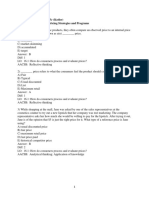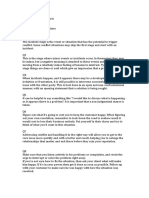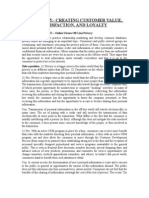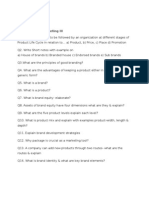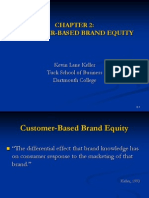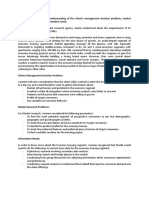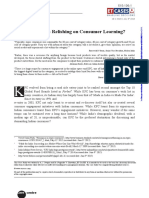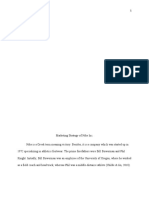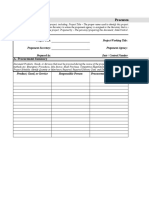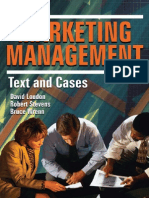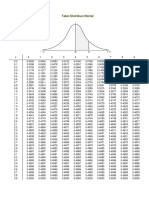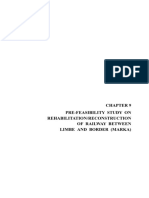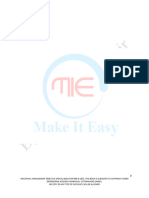Marketing Research-An Applied Orientation
Marketing Research-An Applied Orientation
Uploaded by
Cristina DamianCopyright:
Available Formats
Marketing Research-An Applied Orientation
Marketing Research-An Applied Orientation
Uploaded by
Cristina DamianOriginal Description:
Original Title
Copyright
Available Formats
Share this document
Did you find this document useful?
Is this content inappropriate?
Copyright:
Available Formats
Marketing Research-An Applied Orientation
Marketing Research-An Applied Orientation
Uploaded by
Cristina DamianCopyright:
Available Formats
Book Reviews
Marketing Research: An Applied Orientation
2nd Edition, Pearson Education, Australia
Naresh Malhotra, John Hall, Mike Shaw and Peter Oppenheim (2002)
One of the most important issues in marketing is the collection and analysis of market- related information, and the ability to use and to interpret it. The second edition of Marketing Research: An Applied Orientation claims to provide the knowledge and skills for doing so. It follows on from the success of initial editions in the United States and the related international and Spanish translations. Examples from Australia, New Zealand and Asia in this book allow readers to put theoretical perspectives into tangible local situations, thus increasing interest and understanding. Content The book is organized into seven parts with a total of twenty chapters. Considering this, the opening statement that the organization of the book is according to a conceptualisation of the marketing research process as a six-step framework, somewhat confuses the reader. However, the initial confusion quickly gives way to a full understanding when the framework is explained in Chapter 1 and the progression through the steps is highlighted on the framework at the commencement of each of the following chapters 2 - 20. This step-by-step consideration of the marketing research process makes perfect sense and favourably distinguishes this book from a number of similar publications that start belatedly with the research design and conclude prematurely after the data preparation and analysis step. Part 1 of this book contains four chapters. They cover the first three steps in the marketing research process by providing an introduction to the topic, defining the marketing research problem, developing an approach (including the specification of research objectives), and discussing issues of research design and research proposal. The following Parts 2, 3 and 4 then expand on the third step in the framework: the formulation of the research design. Corresponding chapters 5 - 10 describe research
methodologies extensively. Exploratory, qualitative and quantitative research methods are being addressed in detail with thorough discussions of respective advantages and disadvantages. Not only are types of information presented that are commonly collected in marketing research but additionally the appropriate scales for obtaining them are covered in the individual chapters. Anyone involved in designing questionnaires will appreciate corresponding guidelines that the book provides as well as discussions of procedures, techniques and statistical considerations involved in sampling. Covering data collection and data preparation issues, Part 5 corresponds to the fourth step in the marketing research process. The authors present a discussion of fieldwork and the preparation of data ready for analysis. Actual data analysis, the fifth step, is covered in Part 6. Seven chapters introduce and discuss basic and advanced techniques in detail, including frequency distributions, cross- tabulations, hypotheses testing, analysis of variance, regression analysis, discriminant analysis, factor analysis, cluster analysis, multi-dimensional scaling and conjoint analysis. Emphasis is placed on a thorough explanation of procedures, interpretation of results and managerial implications, although with little attention given to alternative statistical approaches. Part 7 deals with communicating the research project, constituting the sixth and final step in each marketing research process. Details and issues of report preparation and oral presentation are presented in the corresponding single chapter. Changes from the First Edition The strengths of this book remain its depth and breadth of coverage of the marketing research process. A distinct improvement compared to the first edition is that chapters have been reorganized and now provide an enhanced structure corresponding to the marketing research
72
Australasian Marketing Journal 10 (2), 2002
Book Reviews
process. Accordingly, Chapter 1, introduction to marketing research, has been expanded. Chapter 5, secondary data methods, has been supplemented by an extensive section on electronic and Internet research, now including coverage of hot issues like scanner data, computerized databases and the World Wide Web as an on-line source of secondary data. Completely rewritten and also expanded, Chapter 6, qualitative research methods, in its updated form now provides a good coverage of related techniques and applications addressing focus groups, in-depth interviews, projective techniques and the analysis of qualitative data. Although not as extensive as the seven chapters on quantitative research, it now reflects the widespread and varied use of qualitative research. Few marketing research texts give adequate coverage to observation as a research technique. This chapter provides a rationale for using qualitative research, and lays out the procedures by which observational data can be systematically and objectively collected. Upgrading the first editions one-colour printing to a two-colour layout (black and red) added to the ease of navigation in the second edition. Numerous figures, tables, pictures, illustrations and examples help explain the basic concepts. International and Internet examples have been added to most chapters making the book more appealing to a broader audience. The applicability of the book has been improved by inclusion of SPSS output examples along with guidelines on how to run SPSS in order to execute all statistical procedures. Although SPSS is clearly the software application preferred by the authors, marketing research data analysis procedures are illustrated along with other popular programs like SAS, BMDP, Minitab and Excel. The new edition also comes with a CD that includes a SPSS student version and data sets for various comprehensive case studies covered in the book. More and updated case studies are presented in a special section at the end of the book. Finally, a new Companion website ha been set up (www.prenhall.com/ malhotra_au). Suitability for Target Audiences The purpose of this book goes beyond a mere familiarization of readers with a variety of popular techniques used in the collection and analysis of marketing research. It aims at developing an ability to collect, use and interpret marketing information. With the more balanced coverage of both qualitative and quantitative techniques, the content is comprehensive, practical and up to date.
Among the beneficiaries of this book are research suppliers who will find the additional provision of extensive descriptions of research methodologies valuable. The how-to approach throughout the chapters certainly appeals to marketing research practitioners and the abundance of examples makes it easy to transfer the procedures to a particular task at hand. Moreover, the ways in which managers use marketing research findings to improve decisions are continually emphasized throughout the text. The inclusion of additional tools such as the research brief outline and the research proposal outline emphasizes the business and managerial orientation. Nevertheless, a familiarity with basic marketing concepts (e.g. positioning, loyalty, advertising effects) is desirable for using the book effectively. A sufficient number of indices and glossary terms at the end of the edition also make for easy use of the text as a reference book. There is no doubt, that in addition to its value to marketing research practitioners, the book should be recommended for adoption as a textbook at both the undergraduate and postgraduate level. The depth and breadth of topics encompass both levels. The support package accompanying the text is impressive, including a Web site, an Instructors Manual, PowerPoint slides, exercises in marketing research, and a test bank. While the Web site (www.pearsoned.com.au/cw/) contains PowerPoint slides, the Instructors Manual - closely tied to the text offers specific suggestions for teaching each chapter at the undergraduate and postgraduate levels. In addition, answers to all end-of-chapter exercises as well as a complete set of solutions to all cases are provided. The companion SPSS-CD-ROM contains a student version for SPSS 10.0, data files for selected case studies and two corresponding questionnaires. Structured by chapter, the test bank holds multiple response, true / false, and definitional questions as an input for designing exams or quizzes. All the commonly used univariate and multivariate data analysis techniques are discussed extensively yet simply, making the book suitable not only for use in courses on marketing research but also in courses on research methods and marketing data analysis. I particularly liked the way in which statistics associated with various analyses (i.e. ANOVA, regression, discriminant, factor, cluster, conjoint analysis and MDS) are introduced at the very end of each data analysis chapter; these give a comprehensive overview and students can easily refer to the definitions. As appears to be almost mandatory for text-
Australasian Marketing Journal 10 (2), 2002
73
Book Reviews
books with a U.S. American background, the publication could serve as a role model for a didactically valuable structuring of the content: Each chapter unfolds according to the following sequence: objectives - overview basic concept - specifics - summary - key terms and concepts - acronyms - exercises - internet and computer exercises - notes. Considering the layout, the newly introduced second (red) colour is used sparingly for emphasis, highlighting (e.g. headlines), figure components, and World Wide Web sections. This adds to a crisp and visually appealing layout. A problem of general nature, that is not restricted to this book, is that URLs listed under Internet and computer exercises do not stay current (e.g. www.depaul.edu/ethics). Coverage of Research Objects The new edition has been revised and upgraded with numerous real life examples offering instructors, students and research suppliers a very good coverage of objects and regions. Although with a geographical focus on the larger Asia-Pacific region, the range of international examples extends beyond Australia and New Zealand, covering cases from China, Japan, Saudi Arabia, Brazil, the U.S. and other countries around the world. Accordingly, cultural differences and their implications for different stages in the marketing research process are repeatedly emphasized, a refreshing wider perspective when compared with U.S.-only textbooks that sometimes seem to neglect the fact that there is a world outside the national borders. The range of objects covered by the Australasian edition contains the full spectrum of products and services that one may encounter when conducting marketing research: from consumer goods, to financial services, to tourism and hospitality marketing, to agricultural products, to governmental and non- profit marketing challenges.
Summary Based on an original American text that is itself a valuable contribution to any marketing research subject, this Australasian perspective is a much improved and highly recommended edition. It draws on the strengths of the original and the authors seamlessly integrate material to reflect marketing research practice in the larger Asia-Pacific region. The regionalisation of the text is very well accomplished. The book achieves a comprehensive introduction to marketing research with a balanced coverage of both quantitative and qualitative techniques. Several significant changes have been made to make it more relevant to an audience in Australia, New Zealand, and Asia. This includes the addition of new practitioners perspectives, examples, figures, technology updates, electronic and Internet marketing notes, and a revised and expanded chapter on qualitative research. Combining both easy reading with considerable depth of coverage, this is an excellent textbook for both undergraduate and postgraduate students, providing them with examples of current practice. Beyond its usefulness for students of modern marketing research, the text is also a valuable resource for managers who are either commissioning research or disseminating and operationalising its results. However, the updates and additions come at a price. Counting over eight hundred pages, the book places itself among the heavyweight publications. Despite the recommended retail price of $89.95 AUS, the book is a highly recommended buy providing much more than just an applied orientation. Ulrich R. Orth Professor of Agribusiness Marketing Oregon State University
74
Australasian Marketing Journal 10 (2), 2002
You might also like
- Global Marketing Management, 8th Edition Kotabe 2019 Test Bank and SolutionsDocument17 pagesGlobal Marketing Management, 8th Edition Kotabe 2019 Test Bank and SolutionsStudentt Saverr0% (2)
- MKT400 Ch01Document32 pagesMKT400 Ch01Aboi BoboiNo ratings yet
- Strategic Brand Management - Keller-Chapter 3 PDFDocument54 pagesStrategic Brand Management - Keller-Chapter 3 PDFHammert Runner78% (9)
- IKEA Segmentation, Targeting and Positioning - Targeting Cost-CoDocument3 pagesIKEA Segmentation, Targeting and Positioning - Targeting Cost-CoMohamed Awad0% (1)
- MG412 CW2 Brand Extension Report 1Document6 pagesMG412 CW2 Brand Extension Report 1syeda salmaNo ratings yet
- Chapter 16 Developing Pricing Strategies and ProgramsDocument40 pagesChapter 16 Developing Pricing Strategies and ProgramsEng Eman Hannoun100% (2)
- Event Marketing ProjectDocument105 pagesEvent Marketing Projectchimanshu7788894% (32)
- Marketing Research Case #1 BurkeDocument2 pagesMarketing Research Case #1 BurkeDaedricLord Lebanidze50% (2)
- Consumer Buying Behaviour in The Sport ShoesDocument13 pagesConsumer Buying Behaviour in The Sport ShoesSandip Patel100% (2)
- Kotler Mm14e Im 03 GEDocument20 pagesKotler Mm14e Im 03 GEStudy Purpose100% (2)
- Perceptual MapDocument17 pagesPerceptual Mapthu_bui_18100% (1)
- Listerine Question2Document3 pagesListerine Question2Teté RNo ratings yet
- Communication Tools of Coca ColaDocument16 pagesCommunication Tools of Coca ColaWajid Ali79% (14)
- Case Study - STPDocument5 pagesCase Study - STPSimran SathiNo ratings yet
- FMCG Porters Five Forces ModelDocument5 pagesFMCG Porters Five Forces ModelMuhammad Zeshan50% (4)
- Event MarketingDocument42 pagesEvent MarketingCristina DamianNo ratings yet
- Assessment E - Scenario SITXCOM005 T1Document5 pagesAssessment E - Scenario SITXCOM005 T1Pahn PanrutaiNo ratings yet
- BM - PPT 1Document71 pagesBM - PPT 1Sanjoli Jain100% (1)
- Consumer Solution Manual For Consumer Behavior 11th Edition Schiffman, WisenblitDocument28 pagesConsumer Solution Manual For Consumer Behavior 11th Edition Schiffman, WisenblitDebra Johnson50% (2)
- Chapter 5:-Creating Customer Value, Satisfaction, and LoyaltyDocument10 pagesChapter 5:-Creating Customer Value, Satisfaction, and Loyaltyapi-3753113100% (4)
- Lecture Notes in Building Strong BrandsDocument7 pagesLecture Notes in Building Strong BrandsFatima BagayNo ratings yet
- Brand Management Question BankDocument3 pagesBrand Management Question Bankmahesh_thadani6743No ratings yet
- Strategic Brand Management Chapter 02Document30 pagesStrategic Brand Management Chapter 02Bilawal Shabbir60% (5)
- Research Problems, and Information NeedsDocument6 pagesResearch Problems, and Information NeedsprasannaNo ratings yet
- Final Exam Study Guide - MarketingDocument4 pagesFinal Exam Study Guide - MarketingNicole McCoy Wilson50% (2)
- Final Exam MarketingDocument28 pagesFinal Exam MarketingRohan HazraNo ratings yet
- Marketing ResearchDocument11 pagesMarketing ResearchAdam KellyNo ratings yet
- Building Brand Reputation Through Marketing Mix - A Case Study On AARONGDocument15 pagesBuilding Brand Reputation Through Marketing Mix - A Case Study On AARONGUzzal Sarker - উজ্জ্বল সরকারNo ratings yet
- Marketing Question Bank 2015-173rd Semoct 2016Document43 pagesMarketing Question Bank 2015-173rd Semoct 2016akash jainNo ratings yet
- Schiffman CB10 PPT 08Document45 pagesSchiffman CB10 PPT 08omer, hassan100% (1)
- Brand Management Chapter 1 Kevin Lane KellerDocument18 pagesBrand Management Chapter 1 Kevin Lane KellerRiya ShahNo ratings yet
- Brand Management - Assignment 3 (17020448035)Document23 pagesBrand Management - Assignment 3 (17020448035)Tejeshwar SinghNo ratings yet
- Emerging ThemesDocument2 pagesEmerging ThemesAhmad HaqqiNo ratings yet
- Consumer Behavior Final Exam ReviwDocument11 pagesConsumer Behavior Final Exam ReviwDavid ByarsNo ratings yet
- Tentative Questions Students B2B MarketingDocument1 pageTentative Questions Students B2B MarketingVamsee Krishna Vyas BNo ratings yet
- Foreign Segment in Usa Market QuestionsDocument2 pagesForeign Segment in Usa Market QuestionsSheikh Humayoun Farid67% (3)
- KFC INDIA RELISHING ON CONSUMER LEARNING - Case StudyDocument18 pagesKFC INDIA RELISHING ON CONSUMER LEARNING - Case StudySaniya sohailNo ratings yet
- Level 6 (Intermediate) : Diploma in Professional MarketingDocument16 pagesLevel 6 (Intermediate) : Diploma in Professional MarketingSajeed AlamNo ratings yet
- Cim Level 7 Postgraduate Diploma in Professional Marketing Qualification AmendmentsDocument16 pagesCim Level 7 Postgraduate Diploma in Professional Marketing Qualification AmendmentstatendaNo ratings yet
- Consumer BehaviorDocument9 pagesConsumer BehaviorNardsdel Rivera0% (1)
- Marketing EthicsDocument19 pagesMarketing EthicsM_saber_AVNo ratings yet
- Marketing Strategy AssignmentDocument14 pagesMarketing Strategy AssignmentYasin Hassan100% (1)
- Consumer Behavior 1st QuizDocument4 pagesConsumer Behavior 1st Quizrody19857257No ratings yet
- Mkt101 Chapter 4 QuizletDocument15 pagesMkt101 Chapter 4 QuizletHằng ĐỗNo ratings yet
- Marketing Plan AssignmentDocument13 pagesMarketing Plan AssignmentMiles 40100% (1)
- NFL Case Study 3Document5 pagesNFL Case Study 3VarunNo ratings yet
- Chapter 9 Marketing Segmentation Targeting and PositioningDocument37 pagesChapter 9 Marketing Segmentation Targeting and PositioningWilliam Zhang100% (1)
- Customer Based Brand Equity and Brand Positioning.: Branding StrategyDocument44 pagesCustomer Based Brand Equity and Brand Positioning.: Branding StrategyRameen ZafarNo ratings yet
- Chapter 6Document17 pagesChapter 6Adam KellyNo ratings yet
- Marketing Research-Case Study 1Document9 pagesMarketing Research-Case Study 1Razzel VergaraNo ratings yet
- Trader Joe AnalysisDocument6 pagesTrader Joe Analysisapi-543422438No ratings yet
- Identify Target Audience & Determine ObjectivesDocument10 pagesIdentify Target Audience & Determine Objectivesviv3kswamyNo ratings yet
- Chapter 1 Introduction To Marketing ResearchDocument21 pagesChapter 1 Introduction To Marketing ResearchAhmad SheiKh100% (1)
- Chapter 6 Business To Business B2B MarketingDocument32 pagesChapter 6 Business To Business B2B MarketingWilliam ZhangNo ratings yet
- Case StudyDocument14 pagesCase StudyRohit LouisNo ratings yet
- Defining The Marketing Research Problem and Developing An Approach True/False QuestionsDocument16 pagesDefining The Marketing Research Problem and Developing An Approach True/False QuestionsRaza SamiNo ratings yet
- Target MarketingDocument7 pagesTarget MarketingJhuniorNo ratings yet
- Why Integration Marketing: Essential of Integrated Marketing CommunicationsFrom EverandWhy Integration Marketing: Essential of Integrated Marketing CommunicationsNo ratings yet
- Procurement EXCELDocument3 pagesProcurement EXCELCristina DamianNo ratings yet
- English Grammar TensesDocument38 pagesEnglish Grammar Tensesapi-283719185No ratings yet
- Marketing ManagementDocument390 pagesMarketing ManagementFotini Diafa100% (3)
- Oxo Act01 b303 As01 XxaannDocument3 pagesOxo Act01 b303 As01 XxaannMaisieNo ratings yet
- Blake and Volpone RevisionDocument48 pagesBlake and Volpone Revisionnyrayasin13No ratings yet
- 09 Moon Landing - Conspiracy Theories That It's All A Fake - KidsNewsDocument4 pages09 Moon Landing - Conspiracy Theories That It's All A Fake - KidsNewsSIQIAN LIUNo ratings yet
- Machiavellian Is MDocument17 pagesMachiavellian Is MinezbettyswiftNo ratings yet
- Tabel Distribusi Normal 0-Z PDFDocument1 pageTabel Distribusi Normal 0-Z PDFAprilia PutriNo ratings yet
- Derek Dodson PHDDocument342 pagesDerek Dodson PHDraokin2No ratings yet
- Prefeasibility Study LIMBE and MarkkaDocument166 pagesPrefeasibility Study LIMBE and MarkkaCEG BangladeshNo ratings yet
- Week 3 Key AnswersDocument3 pagesWeek 3 Key Answerssarahjanevidad07No ratings yet
- Library Science Ugc Net PDFDocument687 pagesLibrary Science Ugc Net PDFSelim Mokhlasur RahmanNo ratings yet
- Inceptez Fullstack Datascience, Bigdata and Cloud 2021Document36 pagesInceptez Fullstack Datascience, Bigdata and Cloud 2021pavan kumarNo ratings yet
- Unit 3 Expert Systems and ApplicationsDocument28 pagesUnit 3 Expert Systems and ApplicationsshradhaNo ratings yet
- Second Law of ThermodynamicsDocument33 pagesSecond Law of ThermodynamicsSInowritaNo ratings yet
- OmnixDocument1 pageOmnixKania LouisNo ratings yet
- CHAPTER I Introduction To History: Definition, Issues, Sources, and Method Lesson 1 Definition and Subject MatterDocument25 pagesCHAPTER I Introduction To History: Definition, Issues, Sources, and Method Lesson 1 Definition and Subject MatterHoney MaeNo ratings yet
- Gas Scrubbing - General: Synonyms, Abbreviations And/or Process NamesDocument6 pagesGas Scrubbing - General: Synonyms, Abbreviations And/or Process NamesFedoua BenamerNo ratings yet
- Kamed English Teacher. Present Perfect PDFDocument46 pagesKamed English Teacher. Present Perfect PDFKamed GarciaNo ratings yet
- 143_RRB_JE_MCQ_Industrial_MCQ_RRB_INDUSTRIAL_MANAGEMENT_FOR_ - CopyDocument72 pages143_RRB_JE_MCQ_Industrial_MCQ_RRB_INDUSTRIAL_MANAGEMENT_FOR_ - CopybcggNo ratings yet
- BTECDocument2 pagesBTECJoshu WainNo ratings yet
- Convention of Film Blocking Day 2Document6 pagesConvention of Film Blocking Day 2GENELYN GAWARANNo ratings yet
- YONGLI Corporate BrochureDocument12 pagesYONGLI Corporate Brochurericardo.vendasNo ratings yet
- Sinks & Taps by FrankeDocument42 pagesSinks & Taps by FrankeKeyn StNo ratings yet
- Tuhura Athletics Case Study - Export PromotionDocument19 pagesTuhura Athletics Case Study - Export Promotionmaryam sherazNo ratings yet
- CProg PondiUnivDocument2 pagesCProg PondiUnivBala AnandNo ratings yet
- Four Way Traffic Light ConrolDocument30 pagesFour Way Traffic Light ConrolMuhammad HashiNo ratings yet
- Atuenticação SSL MK AuthDocument1 pageAtuenticação SSL MK AuthHian OliveiraNo ratings yet
- New Range. New Rules.: Transforming The Industry Creating Customer Value Powering A Historic Navy VesselDocument24 pagesNew Range. New Rules.: Transforming The Industry Creating Customer Value Powering A Historic Navy VesselBoris ȚepeșNo ratings yet
- Persuasive EssayDocument34 pagesPersuasive EssayTamuna NatroshviliNo ratings yet
- Truck Blomberg Locomotora EmdDocument17 pagesTruck Blomberg Locomotora Emdlocomotoras.slp100% (1)
- G12 Statement - 28 - 07 - 2021Document1 pageG12 Statement - 28 - 07 - 2021Jabisha MutapaNo ratings yet





